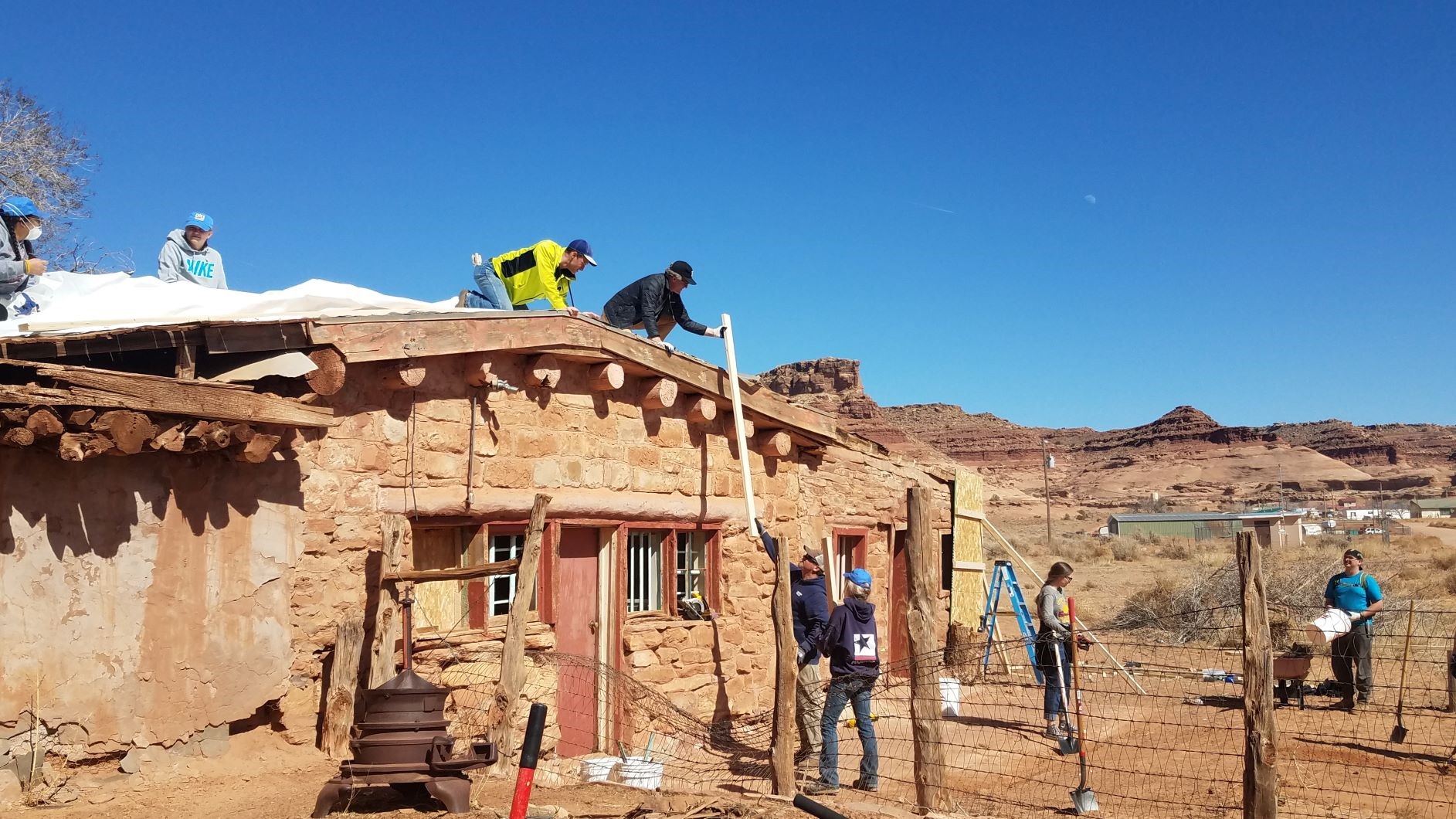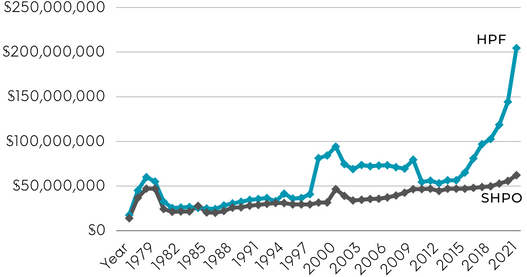The Historic Preservation Fund (HPF) helps State and Tribal Historic Preservation Offices to recognize, save, and protect historic places in communities all over the United States. Reviews of federal projects, surveying and inventorying America’s historic resources, and the successful administration of key programs such the National Register of Historic Places and the Historic Tax Credit Program are the main tools for historic preservation. The State and Tribal Historic Preservation Offices have the primary responsibility for administering these and other preservation programs and rely upon HPF funding.
A variety of grant programs are also funded via the HPF which support historic preservation projects nationwide and ultimately revitalize communities and create opportunities for economic growth. The preservation of historic and cultural sites strengthens local economies by encouraging tourism and creating jobs, and preserves the irreplaceable for future generations.
History of the HPF
Signed into law on September 28, 1976, the Historic Preservation Fund is a federal-state partnership created to assist in the funding of historic preservation efforts.
The HPF is not used for acquisition, rather it provides state and local entities with the resources they need to enable both public and private preservation efforts. To date, the HPF has facilitated 98,000 listings on the National Register of Historic Places and the survey of over 5 million acres for cultural resources, as well as aided in the review of over 177,000 federal undertakings – which allows States and Tribes to give a voice to citizens to federal decision making through the Section 106 process.
The HPF does not use tax-payer dollars, rather, the unique legislation was crafted to utilize a relatively small portion of the royalties that energy companies pay for the right to drill for oil and natural gas on the federally owned Outer Continental Shelf (OCS) to be used to partner with states (and later, Tribes) to preserve the places that tell America’s story. The original idea behind this method was to use the extraction of one non renewable resource (gas/oil), to help fund the preservation of another non renewable resource (historic & cultural assets).
Authorization versus Appropriation
The HPF must be periodically reauthorized by Congress and it is subject to the annual appropriations process. In December of 2016, Congress reauthorized the HPF for seven years, subsequently expiring on September 30, 2023. In March of 2024, the HPF was granted an extension of the current authorization as part of the FY 2024 appropriations process. Under the Interior Appropriations bill, the HPF was extended to September 30, 2024 at the current authorization level of $150 million.
While the authorization amount of the HPF program has been set at $150 million since its inception, it is important to note that despite the authorization amount, Congress can appropriate any amount it desires during the annual appropriations process. This amount therefore, can be more than, equal to, or even less than the amount of the program authorization. In the HPFs history, there have been several years where funds have been authorized for this purpose, but not fully appropriated, and so there remains a balance of unallocated HPF funds.
HPF Appropriation History
- HPF funding rose steadily in the first few years but then decreased drastically starting in 1980
- Incremental increases through the 1990’s, followed by a more than doubling in funding from $40.8 million in 1998 to $81.2 million in 1999 and continued to increase steadily for the next few year (the bulk of this dramatic increase was the result of $35 million allocated for the creation of the Save America’s Treasures Program, $10 million for Historically Black Colleges and Universities, and small increases for SHPOs and THPOs)
- Funding for Save America’s Treasures was eliminated in 2011, however, by 2017 funding started to return – along with several grant programs designed for helping to preserve historic properties in rural communities, to recognize sites associated with the fight for Civil Rights, and for listing properties of underrepresented populations on the National Register of Historic Places.
HPF Today
In Fiscal year 2024, Congress provided $188.666 million for the overall HPF [a decrease of $15.849 million from FY23]. Of this amount, State Historic Preservation Officers (SHPOs) and Tribal Historic Preservation Officers (THPOs) received funding appropriations equal to FY23 levels – $62.15 million, and $23 million, respectively.
Each of our 59 State Historic Preservation Office receives HPF allocations calculated through an apportionment formula managed by the National Park Service. Each state is required to match HPF funds a minimum of 40%. In 2022, NPS undertook an update to the apportionment formula. Each Tribal Historic Preservation Office receives approximately 80% of their total appropriation divided equally among all THPOs and the remaining 20% is apportioned based the area of Tribal lands as defined in the National Historic Preservation Act. *New THPOs are continually added – as of April 2024 there were 222 THPOs.
Congress also provided grant funding as follows:
- $25.5 million for Save America’s Treasures ($1m below FY23)
- $24 million for the African American Civil Rights grant program (equal to FY23)
- $11 million for HBCU preservation grants (equal to FY23)
- $10 million for Paul Bruhn grants ($2.5m below FY23)
- $7 million for the Semiquincentennial grant program ($3m below FY23)
- $5 million for the History of Equal Rights Grant program (equal to FY23)
- $1.25 million for Underrepresented Communities Grants (equal to FY23)
- $19.76 million in Congressionally Directed Spending for HPF Projects ($9.349m below FY23)
Need for Increased Funding
Historic preservation efforts are in urgent need of increased funding to preserve, enhance, and promote the historic and cultural treasures across our nation. Historic preservation remains an underutilized tool in reaching climate goals and furthering efforts on affordable housing. The adaptive reuse of existing buildings keeps quality materials in active use and utilizes their embodied energy – leading to a reduction in carbon output and saving valuable space in landfills. The United States can simply not build its way out of housing problems – solutions lie in investing in returning existing buildings into productive use in a manner that enhances, not detracts from our communities.
While we remain appreciative of the longstanding support Congress has shown for historic preservation efforts – State Historic Preservation Offices are facing particularly challenging circumstances to continue the work that Congress and their State has entrusted to them.
SHPOs take seriously their federally delegated responsibilities of Section 106 review under the National Historic Preservation Act. The FY23 HPF report by the National Park Service highlights a whopping 42.7% increase in federal reviews for SHPOs from the prior year. This uptick has placed immense pressure on SHPO workloads and is likely a direct result of recent Congressionally-led increases to infrastructure investments. While SHPOs remain dedicated to doing their part – increased workloads without additional funding for such efforts is pushing offices to the brink.
A few major challenges facing SHPO offices nationally are: the negative effects of skyrocketing inflation, the inability to recruit and retain qualified staff – which is directly tied to SHPO offices being the lowest paying jobs in the profession, lack of funding to institute or enhance technology needed for efficient workflow management (GIS and application submittal programs especially). NCSHPO will release a report in late 2024 outlining a number of SHPO workforce challenges.
The continued trajectory of SHPO appropriations not keeping pace with the overall increase in HPF funding is proving detrimental. In Fiscal Year 2016, SHPO apportionments accounted for 72% of the total HPF. In Fiscal Year 2024, SHPO apportionments only accounted for 32.9% (down from 44% in FY 2020). Although Tribal Historic Preservation Offices have received some significant bumps in recent years, their funding has also not risen proportionally to the overall HPF. The addition of new Tribes continues to dilute the HPF funding available to each THPO.
SHPOs and THPOs remain the backbone of historic preservation in America and need to be appropriately funded. We look to Congress to provide increased and appropraitely funding for these purposes.

